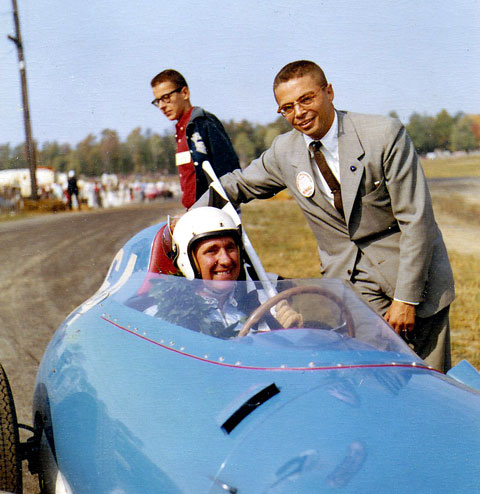 Fiat 1100 powered Formula Juniors were popular at Watkins Glen in 1959 with three entered in the Seneca Cup–an unrestricted Formula Libre race contested by many large engine sports cars and specials as well as pre-war Grand Prix Maseratis.Walt Hansgen, driving the Cunningham Stanguellini Formula Jr., is greeted by race organizer and director Cameron Argetsinger after winning the race. Photo courtesy of Argetsinger family collection.
Fiat 1100 powered Formula Juniors were popular at Watkins Glen in 1959 with three entered in the Seneca Cup–an unrestricted Formula Libre race contested by many large engine sports cars and specials as well as pre-war Grand Prix Maseratis.Walt Hansgen, driving the Cunningham Stanguellini Formula Jr., is greeted by race organizer and director Cameron Argetsinger after winning the race. Photo courtesy of Argetsinger family collection.
By Karl Ludvigsen
Getting by with a little help from its friends
The Fiat-based Cisitalias that made their racing debut in September of 1946 hit the post-war motoring world like an earthquake. They were developed from the 500 cc Fiat chassis and 1100 cc engine and refined with such niceties as a tubular frame. Designer-builders such as Alfredo Vignale and Pinin Farina helped give Cisitalia its reputation of being the car of tomorrow.
Although the cars were raced by greats-to-be Alberto Ascari and Fangio, as well as such pre-war stars as Tazio Nuvolari, Louis Chiron and Raymond Sommer, it was Cisitalia owner Piero Dusio himself who brought the Cisitalia Fiat one of its best moments when he won Turin’s Coppa Brezzi. But Cisitalia’s finest hour may have been in 1951 when New York’s Museum of Modern Art displayed a Pinin Farina coupe as a work of art. Such a car is part of the Museum’s permanent collection.
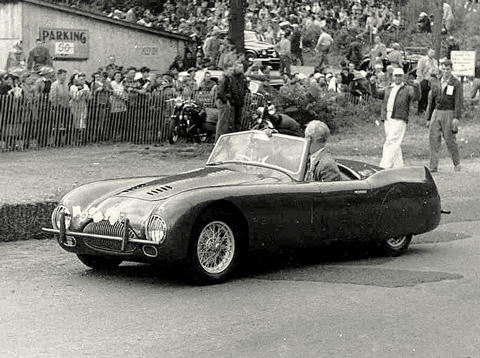 “This is Cisitalia chassis 011SMM owned by Dr. Samuel Scher, noted NY plastic surgeon and collector. Tony Pompeo had it tarted up with bumpers, over-riders, full windshield and top. He never had it raced and sold it to Paul Ceresole, pioneer Boston SCCA racer who ran it at the first Sebring 12 hrs. I bought it around 1970. It was in rough shape and had a Simca engine. I subsequently got a genuine Cissy motor from Jim McGee, the crew chief for the Team Roosevelt Abarth operation,” wrote Gary Ford about this photo by Frank Shaffer.
“This is Cisitalia chassis 011SMM owned by Dr. Samuel Scher, noted NY plastic surgeon and collector. Tony Pompeo had it tarted up with bumpers, over-riders, full windshield and top. He never had it raced and sold it to Paul Ceresole, pioneer Boston SCCA racer who ran it at the first Sebring 12 hrs. I bought it around 1970. It was in rough shape and had a Simca engine. I subsequently got a genuine Cissy motor from Jim McGee, the crew chief for the Team Roosevelt Abarth operation,” wrote Gary Ford about this photo by Frank Shaffer.
Two 1100 cc Fiat sedans and two 1100 cc Cisitalias entered the 1949 races at Watkins Glen. Tony Pompeo’s sedan won class A in the Seneca Cup race while Logan Hill’s Cisitalia captured class honors in the Grand Prix with Joe Ferguson’s Cisitalia 2nd and Pompeo 3rd in class. Russ Boss, Jim Pauley and Tony Pompeo drove Cisitalias at Watkins Glen in 1950. In 1951 a Bandini-Fiat, two Tony Pompeo Siatas, Logan Hill’s Simca and Freddy Proctor’s Siata joined the Fiat brigade. The following October saw more than a dozen Fiat-engined race cars at Watkins Glen when Roger Barlow’s Simca finished 3rd to the Oscas of Big Bill Spear and Gentleman Jim Kimberly in the 1952 running of the Queen Catherine Cup.
 Fred Proctor’s Siata Daina, which placed 12th in the Queen’s Catherine Cup at Watkins Glen in 1951. Hector Scheffer in another Fiat powered Siata placed 3rd. Photo by Frank Shaffer.
Fred Proctor’s Siata Daina, which placed 12th in the Queen’s Catherine Cup at Watkins Glen in 1951. Hector Scheffer in another Fiat powered Siata placed 3rd. Photo by Frank Shaffer.
Highly successful sports cars and single-seaters were constructed around Fiat components by engineer Carlo Abarth and by Vittorio Stanguellini, a Fiat dealer in Modena. Abarth, who worked with Dusio on the aborted Porsche-Cisitalia Formula 1 program, started in business by making exhaust systems. By using Fiat engines and Zagato coachwork, Abarth built some of the fastest cars of the 1960’s.
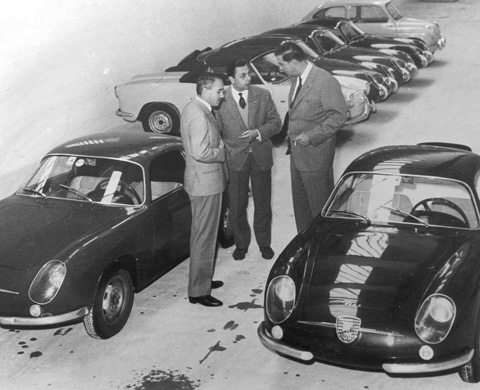 In the late 1950s Fiat in America was distributed on the East Coast by Franklin Delano Roosevelt Jr. Roosevelt also campaigned a team of Fiat Abarths in SCCA events. Here he is at the Abarth factory, (at far right) negotiating the purchase of the latest Fiat Abarth Record Monzas.
In the late 1950s Fiat in America was distributed on the East Coast by Franklin Delano Roosevelt Jr. Roosevelt also campaigned a team of Fiat Abarths in SCCA events. Here he is at the Abarth factory, (at far right) negotiating the purchase of the latest Fiat Abarth Record Monzas.
Best known as the first major builder of Formula Juniors, Stanguellini produced a large number of beautifully-made single-seaters powered by 1100 cc Fiat engines driven through Fiat gearboxes. International Formula Junior honors were taken by Michael May’s Stanguellini in 1959 while Colin Davis won the 1960 Championship driving a Fiat-engined Osca and Taraschi-Fiat.
In December, 1959, Alec Ulmann brought modern Grand Prix racing to the United States. As Count Lurani, a close friend of the Sebring promoter, was Formula Junior’s patron saint, the Juniors had their own race. Briggs Cunningham entered three Alfred Momo-prepared Fiat-powered Stanguellini. Predictably, they finished 1-2-3 with Walt Hansgen taking the checker.
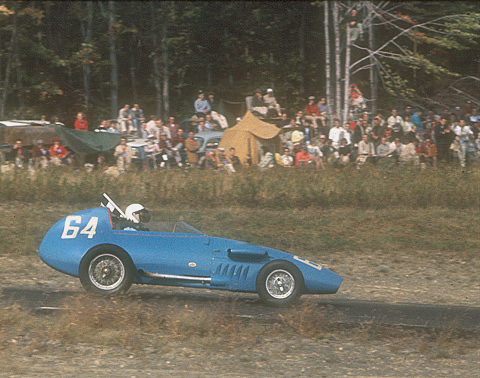
Walt Hansgen tours Watkins Glen in 1959 with the checkered flag after posting the first win by a Formula Junior car in America. In December, Hansgen would again win with the Stanguellini at Sebring. Photo by Ade Ketchum, courtesy Argetsinger family collection.
For Alfred Momo, Cunningham’s revered chef d’equipe, it was a poignant weekend. An apprentice machinist for Fiat in Turin in 1912, Alfred Momo was turned toward the new world by Fiat when, in 1920, they sent him to work as a field representative for Joseph’s, their New York agent.
The Sports Car Club of America’s National Championships came on the scene about this time. Although the SCCA program wasn’t truly national—there were great gaps in its geography—for the aspiring road racer it was the best game in town. What follows is a nostalgic look at some of the SCCA stalwarts who depended on Fiat cars and Fiat-based engines in winning National Championships:
Paul Richards – Fiat-Abarth, 1959 I Production
Chandler Lawrence – Fiat-Abarth, 1960 H Production
Doug Diffenderfer – Siata, 1960 F Production
Ed Astri – Fiat-Abarth, 1962 H Production
Chuck Hamilton – Stanguellini, 1965 Formula C (SE)
Peter Feistman – Fiat-Abarth, 1965 H Production (SE)
Dan Parkinson – Dolphin Abarth, 1965 & 1966 H Sports Racing
Dan Parkinson – Abarth 1000, 1966 & 1967 D Sedan
Fred Plotkin – Abarth Special, 1968 D Sports Racing
Ed Dempsey – Fiat-Abarth, 1968 D Sedan
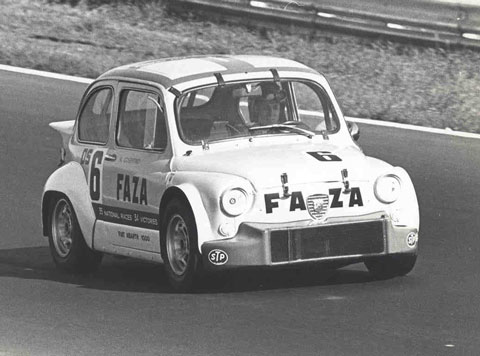 A Faza modified Fiat Abarth brings home a win in a D Sedan event in 1968. Photo by Dobbins.
A Faza modified Fiat Abarth brings home a win in a D Sedan event in 1968. Photo by Dobbins.
Other Fiat racers starred on the national scene without having the consistent record that’s needed to put together a Championship. Among these was one of America’s leading Fiat and Abarth enthusiasts, Al Consentino. On eight separate occasions Al qualified for the big end-of-season SCCA event, the American Road Race of Champions. Another successful Fiat racer was Bob Swenson. His PBS Engineering prepared both sports and racing cars spurred by Fiat power.
The 1979 season brought the best results yet for many Fiat competitors in SCCA races. For the first time the X1/9 came up a winner in SCCA National events. The honor, in G Production class, was shared on the same June day by Richard Davis at Road Atlanta and Kim Baker at Lime Rock. A victory in a Bonus National race, the SCCA’s highest club competition level, went to Californian David Hartsuck at Riverside in his H Production 850 Spider Fiat. Also enjoying success in his 850 Spider was Bill Jucha.
Pininfarina-bodied Fiat Spiders also gained in competitiveness in 1979, recording second-place finishes in SCCA National events in G Production class. Leading exponents of the Spider have been Bill Adrin and Doug Carmean.
Another chapter was added to the story of Fiat competition in the United States in 1979 when Abarth-built Fiats were first entered in performance rallying. This extremely demanding sport, in which road-licensed cars are driven as fast as they’ll go over rocky, rutted forest trails in all weather conditions, is well-known in Europe but relatively new to America.
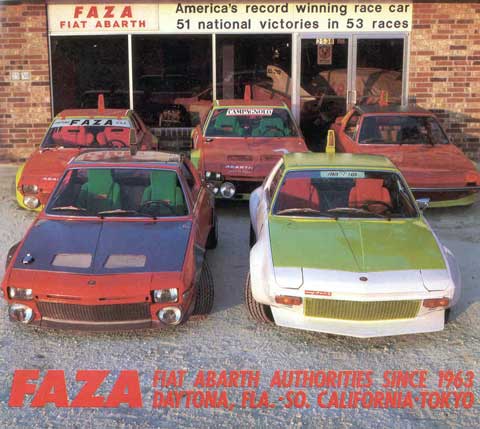 Cosentino continued to race prepare Fiats in the U.S., after moving to California. Here, what seems to be an entire team of Fiat X1/9s line up outside of his dealership. Photo credit Cosentino.
Cosentino continued to race prepare Fiats in the U.S., after moving to California. Here, what seems to be an entire team of Fiat X1/9s line up outside of his dealership. Photo credit Cosentino.
With the sponsorship of Alitalia, two specially-built Fiat Brava rally cars were brought to the United States in 1979 to compete in performance rally events. They were proven European competitors. Cars of the same design had won the World Rally Championship in 1977 and ’78, backed by the Fiat factory team, but they were untested in U.S.-style rallying. Driven by experienced Americans, Jim Walker in eastern events and Danny Goodwin in western rallies, the Fiat Brava Alitalias soon showed they had what it takes to compete on the side of the Atlantic where the sun sets.
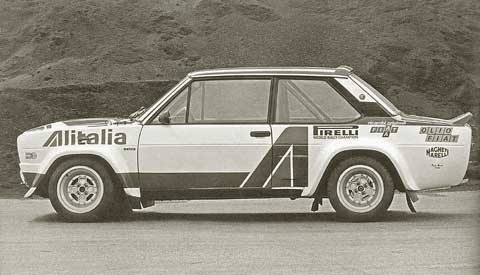 Rare factory shot of the Alitalia Fiat Brava aka 131 Abarth rally car. It did wonders in Europe but was campaigned only in a few events Stateside.
Rare factory shot of the Alitalia Fiat Brava aka 131 Abarth rally car. It did wonders in Europe but was campaigned only in a few events Stateside.
The first Fiats that raced in America were close kin to normal production models. So, too, were the Fiats that took to the track 75 years later. As we’ve seen, Fiat has built its full share of special racing cars, many of which have left their tiremarks on American pavement., But it is indicative of the special spirit that is Fiat that so many of the company’s standard models have also been used for competition.
Epilogue
Since Fiat’s withdrawal from the US market in the 1980s its tire tracks have faded somewhat, save for a continuing role in SCCA racing for the evergreen X1-9 and Fiat’s sponsorship of the Ferrari Formula 1 team. In the 21st Century, however, the prospects for a return are excellent in view of the potential involvement of Fiat in the fate of Chrysler. Its revival of Abarth also speaks well for a likely racing role in America for Fiat in the future. Should it return to American tracks Fiat will find that it has a heritage well worth celebrating.
Notes, credits, references:
A biography of Walt Hansgen was written by Michael Argetsinger and reviewed in VeloceToday. Copies can still be ordered from David Bull Publishing.
Photographer Frank Shaffer took his Leica to the first three Watkins Glen events and captured many of the French and Italian cars both on and off the track.
FRD Jr. was a legend with a legendary race team. VeloceToday contributor wrote the complete history of the team and we’ll be reproducing it in full length later this year.
Al Cosentino proved that the squeaky wheel gets the grease but not always the truimph, while the quite guys at PBS often did better with no fanfare. Energetic, wild, but often brilliant, Cosentino did the SCCA his way.
For other Fiat references in VeloceToday:
Part I, The Racing Fiats in America
Part II, The Racing Fiats in America
Cisitalia Brochure
Articles on or about Fiat
I had one of Bob Swenson’s PBS Coupes and a PBS based sports racer which my racing partner raced in Vintage events. The Fiat X1-9 engine in the sports racer was bullet proof, depandable and would lap tracks with faster times than my Legrand MK-4 with a Buick 215 cu. in. V-8.
Al Cosentino also employed Canadian driver Craig Fisher, who drove the Fiat Abarth 1000 TCR Corsa to many SCCA wins. He later was driving Camaros in Trans Am with Mark Donohue for the Penske team. Roger Penske said Fisher was “like money in the bank.”
Al’s 1000TCR is now on display at the Collier Museum
I see David Lucy wrote on 4-23-09 “I had one of Bob Swenson’s PBS Coupes and a PBS based sports racer which my racing partner raced in Vintage events.” I believe that I currently have the car he is talking about… can I get his email? Mine is: fairchildes@hotmail.com
I was a member of Team Roosevelt and knew John Norwood, the drivers and, of course, Jim McGee, the crew chief, with whom I spent a summer in 1960.
Has the article on the complete history of the team been published? If so, I should like to get a copy and correspond with the author.
Incidentally, it was a book on sports cars by Karl Ludvigsen and another author that first got me interested in them back in the mid-Fifties.
Thank you,
Sheridan Brinley
A new subscriber, I did a search on Abarth Record Monza and this article popped up. I was curious because I own a 1961 1000 Bialbero Record Monza that I am 95% sure, but can’t prove, was raced in the 12 hour race at Sebring in 1961 by DFL of Chicago. The car has a 17 gallon fuel tank, a 2 quart extension welded to the side of the Abarth 6 quart sump, and blocks attached to the insides of the 36 DCL4 float bowls to keep the float travel down, and seat back hinges welded up. Looking at the results of the 1961 race, a “Fiat Abarth Monza” finished 40th but was not classified due to too few laps. The photos look like ny car, right down to the mirror on the right front fender where an antenna was stuck when I got the car. Can any Sebring historians shed any light on this?
I have the Fiat 131 ABARTH(Brava) in our abarth-works museum
Car is now back in his Alitalia Colors and I am looking for some info about this car
EX jim walker:goodwin
Hello to Everyone,
Awesome comments; my Dad was James (Jim) McGee
Chief Mechanic/Crew Chief of Roosevelt Racing Team & the nostalgia of being a child watching Dad prepare the Fiat Abarths at his garage in Water Mill, L.I., NY was priceless. Went with him to several races & just seeing these remarkable cars and drivers perform was breathtaking. Great memories will always be with me. Racing is a Team effort; all of the people I met were 110% + dedicated & we were so proud to have known them. Great Sheridan Brinkley that your comment brought back this precious time in life. Keep the love of cars & people going.
Ann C. McGee